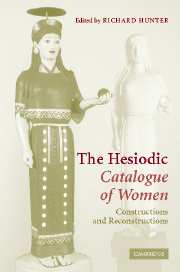Book contents
- Frontmatter
- Contents
- Notes on contributors
- Acknowledgements
- List of abbreviations
- Introduction
- 1 Ordering women in Hesiod's Catalogue
- 2 The beginning and end of the Catalogue of Women and its relation to Hesiod
- 3 Gods among men? The social and political dynamics of the Hesiodic Catalogue of Women
- 4 Heracles in the Hesiodic Catalogue of Women
- 5 Mestra at Athens: Hesiod fr. 43 and the poetics of panhellenism
- 6 A catalogue within a catalogue: Helen's suitors in the Hesiodic Catalogue of Women (frr. 196–204)
- 7 Pulp epic: the Catalogue and the Shield
- 8 The Megalai Ehoiai: a survey of the fragments
- 9 Ordered from the Catalogue: Pindar, Bacchylides, and Hesiodic genealogical poetry
- 10 The Hesiodic Catalogue and Hellenistic poetry
- 11 From genealogy to Catalogue: the Hellenistic adaptation of the Hesiodic catalogue form
- 12 The Hesiodic Catalogue of Women and Latin poetry
- 13 Or such as Ovid's Metamorphoses …
- Bibliography
- Index of passages discussed
- General index
8 - The Megalai Ehoiai: a survey of the fragments
Published online by Cambridge University Press: 22 September 2009
- Frontmatter
- Contents
- Notes on contributors
- Acknowledgements
- List of abbreviations
- Introduction
- 1 Ordering women in Hesiod's Catalogue
- 2 The beginning and end of the Catalogue of Women and its relation to Hesiod
- 3 Gods among men? The social and political dynamics of the Hesiodic Catalogue of Women
- 4 Heracles in the Hesiodic Catalogue of Women
- 5 Mestra at Athens: Hesiod fr. 43 and the poetics of panhellenism
- 6 A catalogue within a catalogue: Helen's suitors in the Hesiodic Catalogue of Women (frr. 196–204)
- 7 Pulp epic: the Catalogue and the Shield
- 8 The Megalai Ehoiai: a survey of the fragments
- 9 Ordered from the Catalogue: Pindar, Bacchylides, and Hesiodic genealogical poetry
- 10 The Hesiodic Catalogue and Hellenistic poetry
- 11 From genealogy to Catalogue: the Hellenistic adaptation of the Hesiodic catalogue form
- 12 The Hesiodic Catalogue of Women and Latin poetry
- 13 Or such as Ovid's Metamorphoses …
- Bibliography
- Index of passages discussed
- General index
Summary
If Leo seems to have demonstrated to everyone's satisfaction that the Hesiodic Γυναικῶν Κατάλογος was the same poem as the Ehoiai, the relation between the Catalogue and the Megalai Ehoiai (hereafter ME) remains much more debated. The fragments attributed to the ME by ancient sources are separately printed in the edition of Merkelbach and West, and West 1985a treats them as belonging to a poem different from the Catalogue. The view that the two titles refer to two, more or less different, editions of the same poem is, however, fairly widespread. Schwartz 1960 and Cohen 1986, for example, thought that the two were essentially the same poem known by two different titles, while others, like Casanova 1979b, have argued that the ME was an expanded version of the Catalogue. Schwartz and Cohen have further argued that sources referring to either work by different titles did so because they had no firsthand acquaintance with the texts. My opinion is that substantial differences in content, focus, and, to a limited extent, narrative technique between the remains of the two poems can hardly be denied. While this may be seen as not incompatible with the hypothesis that the ME was a substantially expanded and modified version of the Catalogue, I see no unambiguous evidence that it was not a completely separate poem belonging to the same poetic tradition.
- Type
- Chapter
- Information
- The Hesiodic Catalogue of WomenConstructions and Reconstructions, pp. 176 - 216Publisher: Cambridge University PressPrint publication year: 2005
- 5
- Cited by



